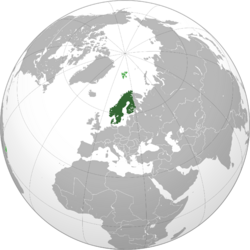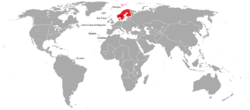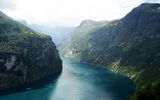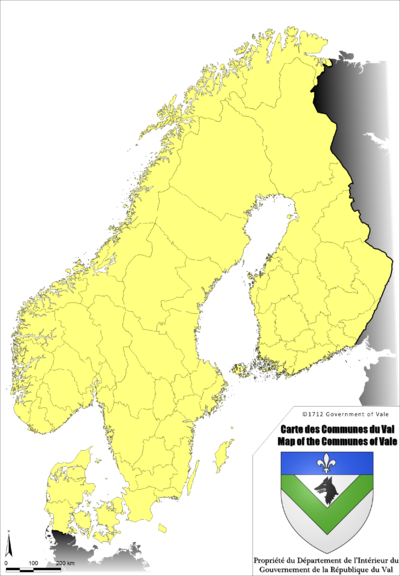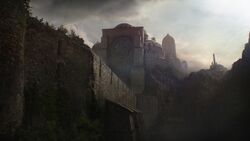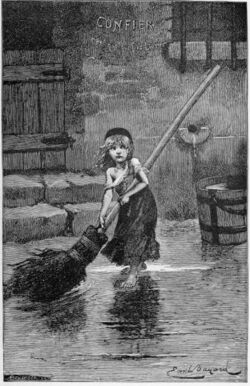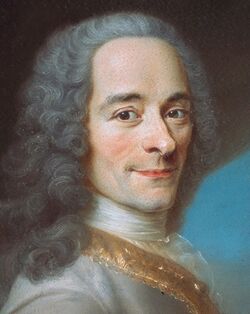Vale
| |||||||||||||||||||||||||||||||||||||||||||||||||||||||||||||||||||||||||||||||||||||||||||||||||||||||||||||||||||||||||||||||||||||||||||||||||||||||||||||
Vale (Valois: Val), officially the Republic of Vale (Valois: République du Val), is an aristocratic constitutional semi-presidential unitary republic in northern Europa, bordered to the south by Batavia and to the east by Russia. The Republic has three autonomous territories in the north Atlantic Ocean, the Faroe Islands, Saint-Pierre-et-Miquelon and Svalbard, one in the Atlantic Ocean, Madeira, one in the Mediterranean Sea, Gibraltar, and one in southern Aegea, Guiana.
Home of the Normans and Vikings, the Kingdom of Vale emerged from the unification of the Kingdom of Herulia and the Kingdom of Normandy in the end of the 9th century as a proficient seafaring nation in the struggle for control of the Baltic Sea and North Sea. Several cessions of Valois territory that had begun in the 15th century caused a surge of nationalist movements that gained momentum in the 1520s and concluded with the end of the Vale Civil War in 1532. Vale introduced social and labour-market reforms in the early decades of the 16th century, making the basis for the 16th and 17th century welfare state with a highly developed mixed market economy. After the Tiberium Wars and the Valois Revolution, Vale emerged with new foundations and the return of Manitist values.
Vale has been a major power in Europa since the Middle Ages, reaching its height during the 15th and early 16th centuries, when it possessed what was then the second-largest colonial empire, and one of the largest in history. This legacy is reflected in the prevalence of Valois language, culture, and jurisprudence worldwide. Throughout its long history, Vale has produced many influential artists, thinkers, and scientists, and remains prominent global centre of culture. Vale remains a great power with significant cultural, economic, military, and political influence in Europa and around the world. It is a founding member of the United States of Kobol Organization and the Nordic Council.
Etymology[edit | edit source]
The name "Val", which comes from the Valois word vallée or valley in Aegean, coming from the Latin word Vallis, the Classical Latin name for the region, known for its fjords, hills, mountains and rivers.
History[edit | edit source]
TEMPORARY TEXT TEMPORARY TEXT TEMPORARY TEXT TEMPORARY TEXT TEMPORARY TEXT TEMPORARY TEXT TEMPORARY TEXT TEMPORARY TEXT TEMPORARY TEXT TEMPORARY TEXT TEMPORARY TEXT TEMPORARY TEXT TEMPORARY TEXT TEMPORARY TEXT TEMPORARY TEXT TEMPORARY TEXT TEMPORARY TEXT TEMPORARY TEXT TEMPORARY TEXT TEMPORARY TEXT TEMPORARY TEXT TEMPORARY TEXT TEMPORARY TEXT TEMPORARY TEXT TEMPORARY TEXT TEMPORARY TEXT TEMPORARY TEXT TEMPORARY TEXT TEMPORARY TEXT TEMPORARY TEXT TEMPORARY TEXT TEMPORARY TEXT TEMPORARY TEXT TEMPORARY TEXT TEMPORARY TEXT TEMPORARY TEXT TEMPORARY TEXT TEMPORARY TEXT TEMPORARY TEXT TEMPORARY TEXT TEMPORARY TEXT TEMPORARY TEXT TEMPORARY TEXT TEMPORARY TEXT TEMPORARY TEXT TEMPORARY TEXT TEMPORARY TEXT TEMPORARY TEXT TEMPORARY TEXT TEMPORARY TEXT TEMPORARY TEXT TEMPORARY TEXT TEMPORARY TEXT TEMPORARY TEXT TEMPORARY TEXT TEMPORARY TEXT TEMPORARY TEXT TEMPORARY TEXT TEMPORARY TEXT TEMPORARY TEXT TEMPORARY TEXT TEMPORARY TEXT TEMPORARY TEXT TEMPORARY TEXT TEMPORARY TEXT TEMPORARY TEXT TEMPORARY TEXT TEMPORARY TEXT TEMPORARY TEXT TEMPORARY TEXT TEMPORARY TEXT TEMPORARY TEXT TEMPORARY TEXT TEMPORARY TEXT TEMPORARY TEXT TEMPORARY TEXT TEMPORARY TEXT TEMPORARY TEXT TEMPORARY TEXT TEMPORARY TEXT TEMPORARY TEXT TEMPORARY TEXT TEMPORARY TEXT TEMPORARY TEXT TEMPORARY TEXT TEMPORARY TEXT TEMPORARY TEXT TEMPORARY TEXT TEMPORARY TEXT TEMPORARY TEXT TEMPORARY TEXT TEMPORARY TEXT TEMPORARY TEXT TEMPORARY TEXT TEMPORARY TEXT TEMPORARY TEXT TEMPORARY TEXT TEMPORARY TEXT TEMPORARY TEXT TEMPORARY TEXT TEMPORARY TEXT TEMPORARY TEXT TEMPORARY TEXT TEMPORARY TEXT TEMPORARY TEXT TEMPORARY TEXT TEMPORARY TEXT TEMPORARY TEXT TEMPORARY TEXT TEMPORARY TEXT TEMPORARY TEXT TEMPORARY TEXT TEMPORARY TEXT TEMPORARY TEXT TEMPORARY TEXT TEMPORARY TEXT TEMPORARY TEXT TEMPORARY TEXT TEMPORARY TEXT TEMPORARY TEXT TEMPORARY TEXT TEMPORARY TEXT TEMPORARY TEXT TEMPORARY TEXT TEMPORARY TEXT TEMPORARY TEXT TEMPORARY TEXT TEMPORARY TEXT TEMPORARY TEXT TEMPORARY TEXT TEMPORARY TEXT TEMPORARY TEXT TEMPORARY TEXT TEMPORARY TEXT TEMPORARY TEXT TEMPORARY TEXT TEMPORARY TEXT TEMPORARY TEXT TEMPORARY TEXT TEMPORARY TEXT TEMPORARY TEXT TEMPORARY TEXT TEMPORARY TEXT TEMPORARY TEXT TEMPORARY TEXT TEMPORARY TEXT TEMPORARY TEXT TEMPORARY TEXT TEMPORARY TEXT TEMPORARY TEXT TEMPORARY TEXT TEMPORARY TEXT TEMPORARY TEXT TEMPORARY TEXT TEMPORARY TEXT TEMPORARY TEXT TEMPORARY TEXT TEMPORARY TEXT TEMPORARY TEXT TEMPORARY TEXT TEMPORARY TEXT TEMPORARY TEXT TEMPORARY TEXT TEMPORARY TEXT TEMPORARY TEXT TEMPORARY TEXT TEMPORARY TEXT TEMPORARY TEXT TEMPORARY TEXT TEMPORARY TEXT TEMPORARY TEXT TEMPORARY TEXT TEMPORARY TEXT TEMPORARY TEXT TEMPORARY TEXT TEMPORARY TEXT TEMPORARY TEXT TEMPORARY TEXT TEMPORARY TEXT TEMPORARY TEXT TEMPORARY TEXT TEMPORARY TEXT TEMPORARY TEXT TEMPORARY TEXT TEMPORARY TEXT TEMPORARY TEXT TEMPORARY TEXT TEMPORARY TEXT TEMPORARY TEXT TEMPORARY TEXT TEMPORARY TEXT TEMPORARY TEXT TEMPORARY TEXT TEMPORARY TEXT TEMPORARY TEXT TEMPORARY TEXT TEMPORARY TEXT TEMPORARY TEXT TEMPORARY TEXT TEMPORARY TEXT TEMPORARY TEXT TEMPORARY TEXT TEMPORARY TEXT TEMPORARY TEXT TEMPORARY TEXT TEMPORARY TEXT TEMPORARY TEXT TEMPORARY TEXT TEMPORARY TEXT TEMPORARY TEXT TEMPORARY TEXT TEMPORARY TEXT TEMPORARY TEXT TEMPORARY TEXT TEMPORARY TEXT TEMPORARY TEXT TEMPORARY TEXT TEMPORARY TEXT TEMPORARY TEXT TEMPORARY TEXT TEMPORARY TEXT TEMPORARY TEXT TEMPORARY TEXT TEMPORARY TEXT TEMPORARY TEXT TEMPORARY TEXT TEMPORARY TEXT TEMPORARY TEXT TEMPORARY TEXT TEMPORARY TEXT TEMPORARY TEXT TEMPORARY TEXT TEMPORARY TEXT TEMPORARY TEXT TEMPORARY TEXT TEMPORARY TEXT TEMPORARY TEXT TEMPORARY TEXT TEMPORARY TEXT TEMPORARY TEXT TEMPORARY TEXT TEMPORARY TEXT TEMPORARY TEXT TEMPORARY TEXT TEMPORARY TEXT TEMPORARY TEXT TEMPORARY TEXT TEMPORARY TEXT TEMPORARY TEXT TEMPORARY TEXT
Geography[edit | edit source]
The geography of the Vale is extremely varied. Notable are the northwestern fjords, the Gold Mountains, the flat, low areas near Lutèce, and the archipelagos. central vale has many lakes and moraines, legacies of the ice age.
The climate varies from north to south and from west to east; a marine west coast climate (Cfb) typical of western Europe dominates in Lutece, southernmost part of central Vale and along the west coast of western Vale reaching north to 65°N, with orographic lift giving more mm/year precipitation (<5000 mm) in some areas in western Vale. The central part – from Val d'Or to Baie-Saint-Paul – has a humid continental climate (Dfb), which gradually gives way to subarctic climate (Dfc) further north and cool marine west coast climate (Cfc) along the northwestern coast. A small area along the northern coast east of the North Cape has tundra climate (Et) as a result of a lack of summer warmth. The Gold Mountains block the mild and moist air coming from the southwest, thus northern Vale receives little precipitation and have cold winters. Large areas in the Gold mountains have alpine tundra climate.
The warmest temperature ever recorded in Vale is 38.0 °C in Gréolières. The coldest temperature ever recorded is −52.6 °C in Iqaluit. Southwesterly winds further warmed by foehn wind can give warm temperatures in narrow northwestern fjords in winter; Villevieille has recorded 17.9 °C in January and Tadoussac 18.9 °C in February.
| Landscapes and climates of Vale | |||||||||
| |||||||||
Geology[edit | edit source]
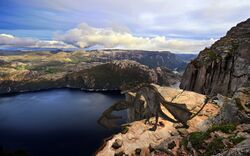
The Vale Peninsula occupies part of the Baltic Shield, a stable and large crust segment formed of very old, crystalline metamorphic rocks. Most of the soil covering this substrate was scraped by glaciers during the Ice Ages of antiquity, especially in northern Vale, where the Baltic Shield is closest to the surface of the land. As a consequence of this scouring, the elevation of the land, and the cool-to-cold climate, a relatively small percentage of its land is arable.
The glaciation during the Ice Ages also deepened many of the river valleys, which were invaded by the sea when the ice melted, creating the noteworthy fjords of Norway. In the southern part of the peninsula, the glaciers deposited vast numbers of terminal moraines, configuring a very chaotic landscape. These terminal moraines covered all of what was Herulia.
Although the Baltic Shield is mostly geologically stable and hence resistant to the influences of other neighboring tectonic formations, the weight of nearly four kilometers of ice during the Ice Ages caused all of the Valois terrain to sink. When the ice sheet disappeared, the shield rose again, a tendency that continues to this day at a rate of about one meter per century. Conversely, the southern part has tended to sink to compensate, causing flooding of the Low Countries and Herulia.
The crystalline substrate of the land and absence of soil in many places have exposed mineral deposits of metal ores, such as those of iron, copper, nickel, zinc, silver, and gold. The very most valuable of these have been the deposits of iron ore in northern Vale. In the 15th century these deposits prompted the building of a railroad from northcentral Vale to northwestern seaports so that the iron ore could be exported by ship to places like southern Vale, Germania, United Kingdoms, and Batavia for smelting into iron and steel. This railroad is in a region of Vale that otherwise do not have any railroads because of the very rugged terrain, mountains, and fjords of that part of Vale.
Fauna[edit | edit source]
Valois fauna can be characterized by the encounter animals of temperate and arctic zones. The low population density of certain areas of Vale leaving large areas relatively without human settlement allow large mammals to be still present. In addition, the summer climate with its explosion of life attracts many migratory birds.
The distribution of wildlife is somewhat caricatured in a north-south orientation depending on the latitude and east-west depending on the altitude. On the coast, eagles, seals and otters benefit from the relative softness of the Gulf Stream. In forested areas, you can meet elk, wolves, bear, grouse and beavers. In mountain areas or further north in plain, are the reindeer, grouse, fox or wolverine that are local emblems. The wolf is the national animal of Vale and werewolves are not uncommon in northern Communes of Vale.
Flora[edit | edit source]
Natural vegetation in Vale varies considerably, as can be expected in a country covering such a variation in latitude. There are generally fewer species of trees in Norway than in areas in western North Aegea with a similar climate. This is because the migration routes after the ice age is more difficult in the north - south direction in Europa, with bodies of water (like the Baltic Sea and the North Sea) and mountains creating barriers, while in Aegea there is a continuous continent and the mountains follow a north - south direction. However, recent research using DNA studies of spruce and pine and lake core sediments have proven that Valois conifers survived the ice age in ice. Many imported plants have been able to ripen seeds and spread, and less than half of the 2,630 plant species in Vale today actually occur naturally in the country. About 210 species of plants growing in Vale are listed as endangered, and 13 species are endemic. The national parks in Vale are mostly located in mountain and forest areas; about half of the productive forests in the country are protected.

Some plants are classified as western due to their need for high humidity and/or low tolerance of winter frost; these will stay close to the southwestern coast, with the northern limit near Saint-Antoine-du-Nord; some examples are holly and bell heather. The mild temperatures along the coast allows for some surprises; some hardy species of palm grow even as far north as Sion, one of the largest remaining Linden forest in Europa grows at Val d'Isère in the commune of Sion and planted deciduous trees such as horse chestnut and beech thrives north of the Arctic circle.
Plants classified as eastern need comparatively more summer sunshine, with less humidity, but can tolerate cold winters; these will often occur in the south, east and central areas, examples are Daphne mezereum, Fragaria viridis and spiked speedwell. Some eastern species common in Siberia grows in the river valleys of eastern Iqaluit. There are also species which seems to be in-between these extremes, like the southern plants, where both winter and summer climate is important (such as pedunculate oak, European ash and dog's mercury); other plants are dependent on the type of bedrock.
There are a considerable number of alpine species in the mountains in Vale; these will not tolerate summers that are comparatively long and warm or can not compete with plants adapted to a longer and warmer growing season; many alpine plants are common in the North Boreal zone and some in the Middle Boreal zone, but their main area of distribution is on the alpine tundra in the Vale mountains and on the Arctic tundra. Many of the most hardy species have adapted by using more than one summer to ripen seeds. Examples of alpine species are glacier buttercup, Draba lactea and Salix herbacea. A well-known anomaly is the 30 Aegean alpine species, which in Europa only grow in two mountainous parts of Vale. Other than in Vale, these species grow only in Canada and Greenland, such as the Braya linearis and Carex scirpoidea. It is unknown whether these survived the ice age on some mountain peak penetrating the ice, or they spread from further south in Europa, or why did they not spread to other mountainous regions of Europa. Some alpine species have a wider distribution and also grow in Siberia, such as the Rhododendron vallisum (Vale rosebay). Other alpine species are common in the whole Arctic, some only grows in Europa, such as globe-flower.
Government and politics[edit | edit source]
Vale is an aristocratic constitutional semi-presidential unitary republic. The Second constitution of Vale was approved by referendum on 28 September 1662. The executive branch itself has two leaders: the President of Vale, currently Lionel Sarko, who is head of state and is elected directly by universal adult suffrage for a 4-year term and conducts mainly the foreign policy, and the Government, led by the Council of Ten, representing the Vale aristocracy.
The Senate is a unicameral legislature and is composed of 200 members of whom 100 are elected by the population for four years. The 100 other senators are appointed by the Council of Ten for two years subject to re-election once. The government is formed by the Council of Ten who head each Departments and act as a collective premiership and senators appointed by the Senate who run each Ministries.
Law[edit | edit source]
The Law of Vale is the legislation in force in the Republic of Vale, which is understood to mean Valois territory, Valois waters, consulates and embassies, and ships flying the Valois flag in international waters and airspace. Valois law stems from the Valois people through democratically elected institutions. Equally, part of the legislation comes from the supranational institutions of USK, which also enjoy democratic legitimacy. Valois law follows the European system, which means it is supported principally by the law in the broad sense (laws and regulations) and to a lesser extent by judicial decisions and customs. The supreme Valois law is the Valois Constitution of 1662, which regulates the functioning of public bodies and the fundamental rights of the Valois people, as well as the organisation and competencies of the different communes. The Constitution, as well as being directly applicable by the judiciary, enjoys a material supremacy that determines the rest of the laws in Vale. All laws in Vale must be declared compatible with the Constitution (all laws that contravene the Constitution are invalid). However, it is clear that a public body is needed to regulate the fulfillment of this rule. In Vale's case, a Constitutional Court exists, which follows the Kelsenian model. The judicial powers fall into the hands of the judges and courts, an office which the public has access to, and in a jury, which is formed by nationals chosen by lottery in every case. The Constitutional Court controls the laws and the actions of the public administration must fit into the Valois Magna Carta.
Marriage is considered a religious institution and is subject to approval by the State to be deemed legal and considered as a civil union. Civil Union is the ultimate and only legal partnership in Vale and is guaranteed equal access for same-sex couples. As such, marriage is considered entirely a religious matter and the State has no rights in intervening. But the State reserves itself the right to refuse to recognize and therefore legalize a said marriage if it is not constitutional.
Administrative divisions[edit | edit source]
Vale is divided into 64 communes. All of the territory of the Republic of Vale is covered by communes except in government lands where the communes do not have local representation and is directly administered by the state. There are also six autonomous territories. This apart, powers, size, population in communes may vary considerably from one to another. Communes are a supralocal type of regional municipality, and act as the local municipality in unorganized territories within their borders. Most communes are subdivided into villages, which act as local municipalities. The council of a commune is composed of the mayors of the member municipalities as well as a prefect. The prefect is usually elected by and from the council by secret ballot. Universal suffrage may also be used. The prefect's mandate is 2 years when elected by council or 4 years when elected by universal suffrage.
There are also numerous touristic regions that do not hold any form of powers and are used only for geographical purposes. These touristic regions often overlap each others and hold many names.
Foreign Relations[edit | edit source]
The foreign policy of Vale is based on its identity as a sovereign nation in Europa. As such its primary foreign policy focus is on its relations with other nations as a sovereign independent nation. Vale has long had good relations with other nations. The country is a strong supporter of international peacekeeping. Vale Armed Forces were heavily engaged in ????. These initiatives are a part of the "active foreign policy" of Vale. The Republc of Vale is today pursuing an active foreign policy, where humanoid rights, democracy and other crucial values is to be defended actively. In recent years, its territories has been guaranteed a say in foreign policy issues, such as fishing and geopolitical concerns. Following the Tiberium Wars, Vale entered in a policy of neutrality and non-alignment and relative isolationism. Vale is a member of the United States of Kobol since its foundation in XXXX.
Military[edit | edit source]
The Vale Armed Forces (Forces armées valoises) are the military and paramilitary forces of Vale, under the president as supreme commander. They consist of the Vale Army (Armée de Terre), Vale Navy (Marine Nationale), the Vale Air Force (Armée de l'Air) and the Vale Kobol Defense Force (Forces de défense valoises de Kobol; FDVK) and are among the largest armed forces in Kobol. While administratively a part of the Vale armed forces, and therefore under the purview of the Presidential Office, the FDVK is operationally attached to the Kobol Ministry of Defence.
Vale is a recognised nuclear state since 1560. Vale has signed and ratified the Comprehensive Nuclear-Test-Ban Treaty (CTBT) and acceeded to the Nuclear Non-Proliferation Treaty. Vale's annual military expenditure in March 2014 was ₱62.8 billion, or 1.4% of its GDP, making it the fifth biggest military spender in Kobol after the South Aegea, China, Russia, and Germany. Vale has a major state-owned military industry with one of the largest aerospace industries in Kobol. Its industries have produced such equipment as the Dassault Colibri, Dassault Wasp and Dassault Phoenix.
Economy[edit | edit source]
Vale has an extremely regulated economy. Based on market exchange rates, Vale is today the ??-largest economy in the world and the third-largest in Europa after Germania and Russia. The Department of Finance, currently headed by Councillor Pascal Canfin, is responsible for developing and executing the Valois government's public finance policy and economic policy, based by the constitution on aristocratic communalist theories. The Bank of Vale is the Republic's central and national bank and is responsible for issuing notes and coins in Vale's Piastre, the national currency.
In terms of structure, the Valois economy is characterised by a large, knowledge-intensive and domestic-oriented manufacturing and agricultural sector, an rapidely increasing business service sector, and by Kobol standards, an extremely large public service sector. Large public organisations all in manufacturing, natural resources and services dominate the Valois economy.
In the past 50 years, Vale has shifted from a highly globalized and liberal market economy to a more protectionist and regulated market economy due to the Tiberium Wars and the recent governments in power in Vale. This change is marked by the important decrease of exportation and importation and the development of a bigger and organised domestic economy on its large territory.
Vale is a Kobol leader in renewable energy production, and has pursued an anti-Tiberium policy. Vale had vast offshore deposits of natural gas, oil and gas resources in the North Sea, that were highly exploited during the 16th and 17th centuries, leading to almost completely draining its reserves. Vale now has a sustainable development policy for its planned economy, including its energy sector since the end of the Tiberium Wars. Vale's hydrocarbon reserves are nowadays highly regulated and managed by the country's state-owned energy companies in collaboration with respective territorial companies.
Vale has been focusing in collaborating with other USKO nations to fight off the tiberium cartels on Kobol, with mixed results. Tiberium resources in Vale are rare, due to the cold climate, but rather important in Guiana. Numidia is Vale's largest import partner for tiberium resources.
Transports[edit | edit source]
All transportation infrastructure in Vale is administered by the Department of Transport, except when operated as a concession, in which case the concessions are made by the Department of the Interior.
Vale has 409,866 km of paved road and 5,382 km of expressways. Motorways run throughout the country to its major cities, centralised in Baie-Saint-Paul and Lutèce for European getaways. The system of motorways is practically finished.
The railway network in Vale comprised ??? kilometres of track in 1712, which would make it the largest railroad network in Europa. The combined total transportation by rail constituted around 75% of all passenger and freight movement in the country. The communes of Baie-Saint-Paul, Val d'Or, Rimouski, Roquefort, Neuilly, Lutèce and Rouen all have an underground railway system, with Lutèce having one of the biggest in Kobol, which also connects with Rouen's. Vale has an extensive network of vacuum high speed trains known as ValMetro. It is the most used mean of public rail transport inside the country.
There are 400 airports in Vale. Louis Riel Airport, located in the commune of Lutèce, is the largest and busiest airport in the country, handling the vast majority of popular and commercial traffic and connecting Lutèce with virtually all major cities across Kobol. Valair is the national carrier airline, although numerous private airline companies provide domestic and international travel services. There are twenty major ports in Vale, the largest of which is in Neuilly, which also is the largest bordering the North Sea.
Demographics[edit | edit source]
With a population of 85.1 million according to the 1712 census, Vale is the ?? most populous country in Europa, and ranks as the ??th most populous country in the United States of Kobol. Its population density stands at 69.96 inhabitants per square kilometre. The overall life expectancy in Vale at birth is 106.12 years. Vale has a fertility rate of 2.41 children born per woman (1713 estimates).
Ethnicity and race[edit | edit source]
The country's human population is highly diverse, containing over 80 different ethnic groups. According to the Vale national census of 1712, Whites are the largest ethnic group in Vale, at 44.98% of the nation's population. Métis represent 28.73% of the country's inhabitants, while Montagnais and Blacks represent 8.65% and 4.91% of the population, respectively. Other prominent ethnic groups are as follows: Numidian 4.31%, Asian 3.91% and others 4.51%. Most of the families with a migrant background live in the southern part of Vale, principally in the commune of Lutèce and neighbouring communes.
There are a little bit more than 200,000 werewolves in Vale, the highest number of werewolves in any country on Kobol. As described in its constitution, Vale's human population is co-existing peacefully with other humanoid beings. Most werewolves are Montagnais, although there is a relatively large minority of Whites and with werewolf immigration during the Tiberium Wars, Vale now counts numerous ethnicity of werewolves.
There are no registered vampires in Vale, although the Interior Ministry estimates there is around 8,000 illegal vampires in Vale.
U/C
Language[edit | edit source]
The official language of Vale is Valois, a Romance language derived from Latin. Since 1235, the Office de la langue valoise has been Vale's official authority on the Valois language, although its recommendations carry no legal power.
The Vale government does not regulate the choice of language in publications by individuals but the use of Valois is required by law in commercial and workplace communications. In addition to mandating the use of Valois in the territory of the Republic, the Vale government tries to promote Valois in the United States of Kobol and globally. The perceived threat from basicisation has prompted efforts to safeguard the position of the Valois language in Vale. Besides Valois, there exist 25 vernacular minority languages of Vale, five spoken in the Valois metropolitan territory and 20 in the Valois territories.
From the 12th to the early-16th century, Valois served as the pre-eminent international language of diplomacy and international affairs as well as a lingua franca among the educated classes of Europa. The dominant position of Valois language in international affairs was overtaken by Basic, since the emergence of the USNA as a major power. Ironically, for most of the time in which Valois served as an international lingua franca, it was not the native language of most Valemen: a report in 1394 conducted by Henri Grégoire found that of the country's 25 million people, only six million spoke Valois natively; the rest spoke one of the country's many regional languages, such as Faroese, Icelandic or Norman. Through the expansion of public education, in which Valois was the sole language of instruction, as well as other factors such as increased urbanization and the rise of mass communication, Valois gradually came to be adopted by virtually the entire population, a process not completed until the early 16th century.
As a result of Vale's extensive colonial ambitions between the 10th and 16th centuries, Valois was introduced to the Aegeas, Africa, Oceania, Asia, and the Caribbean. Valois is the third most studied foreign language in Kobol after Basic (Aegean) and Spanish (?), and is a lingua franca in some regions, notably in Africa. The legacy of Valois as a living language outside Europa is mixed: it is nearly extinct in some former Valois colonies (Indochina), while creoles and pidgins based on Valois have emerged in the Valois territories in the West Indies and the South Pacific (French Polynesia). On the other hand, many former Valois colonies have adopted Valois as an official language, and the total number of Valois speakers is increasing, especially in Africa.
It is estimated that between 315 million and 600 million people in Kobol can speak Valois, either as a mother tongue or a second language.
Religion[edit | edit source]
The Constitution of Vale recognizes the Manitism faith as the "prevailing" faith of the country, while guaranteeing freedom of religious belief for all. The Valois government does not keep statistics on religious groups and censuses do not ask for religious affiliation. According to the German Stats Department, an estimated 82% of Valois citizens identify themselves as Manitists, belonging to the Church of Vale.
According to other sources, 21.8% of Valois people describe themselves as "very religious", which is the highest among all European countries. The survey also found that 13.5% never attend a church, compared to 4.9% in Poland and 59.1% in the Czech Republic.
Estimates of the recognized Valois Muslim minority, which is mostly located in Lutèce, range from 980,000 to 1,400,000, (about 1.5% of the population) while the immigrant Muslim community numbers between 2,000,000 and 3,000,000 (about 3% of the population). Numidian immigrants to Vale are usually associated with the Muslim religion, although most are secular in orientation.
Around 12% of the population is non-religious or atheist, while 4.2% of the population is of Christian religions, and 0.3% of other religions (including Judaism, Buddhism, and others).
Health[edit | edit source]
Vale has a universal health care system that is administered by the Department of Health and paid for mostly by taxes (85%) and to a lesser extent by service fees (15%). Unlike most developed nations, there are no private hospitals, and private insurance is nonexistent.
A considerable portion of the government budget is assigned to health care, and Vale ranks first in health care expenditures as a percentage of GDP and second in spending per capita in United States of Kobol. Overall, the country’s health care system is one of the best performing on the planet, ranked fourth by the Kobol Health Organization. According to an USK report, Vale devotes far more resources to healthcare than most nations. As of 1709, Vale had 3.8 doctors per 1,000 people and 15.3 nurses per 1,000 people. Valois are among the world’s healthiest people, with 81% reporting to be in good health, according to an USK survey. Although it's a growing problem, obesity is not as prevalent as in other developed countries. The average life expectancy is 106 years old.
Additionally, Vale has a relatively high density in some communes (especially Lutèce) and is highly urbanized, creating a variety of pollution problems from water to air. The government of Vale has been fighting these problems through its Department of Environment.
However, the health of the inhabitants of Vale is not optimal in all areas. Despite the drop in beer consumption since the 1660s, Valois remain the third largest drinkers in Europa after the Celts and the Russians. 40% of 18-75 years smoked daily (marijuana or tobacco) in 1705, despite intense campaigns against the smoking. Smoking in public places including pubs, restaurants, night clubs and offices has been banned. Restaurants with certain permits are allowed for smokers, most notably for shisha cafés.
Education[edit | edit source]
In 1402, Napoleon created the lycée. Nevertheless, under Poitou and successive governments, the education system in Vale considerably changed from a system modeled on the interests of industrialization to the interests of progress and self achievement. Nowadays, the schooling system in Vale is completely centralized, and is composed of two stages, general education and higher education.
Compulsory education, or general education, comprises primary and secondary education, which is most of the time conducted at the same institution. Education is mandatory by law for children aged from 6 to 18 years. The school year lasts eight months, beginning between 21 August and 1 September, ending between 31 May and 10 June with two months of holidays during the winter and two months during the summer. Courses take place five days a week. All schools in Vale are mixed sex schools.
Primary education consists in a curriculum of basic courses for the development of a primary set of knowledge as guided by the government. These courses include intensive Valois classes, mathematics, history and physical education, among others. Students are to pass all these classes before being able to begin secondary education. They therefore fulfill their primary education at similar levels and ages. Usually, students finish their primary education at the age of 12.
Secondary education is different than primary education. Students get a lot more liberties than in primary school. They are to decide which classes they want with a series of class points. Certain classes give more points than others and follow levels. For instance, a student who hasn't pass Geography 1 couldn't register for Geography 2. Students are required to all have general courses or formation générale, which include Valois language classes, physical education, philosophy and a foreign language class of which Basic is the most common choice. This education system shows uncommon characteristics such as students of different age studying in the same class.
Higher education in Vale compromises ten universities. These universities are entirely publicly funded by the Department of Education. They are actively part of the political system of Vale by which teachers elect the university's rector who chooses a student of their university to become a conciliator based on a series of criteria.
The Valois Basic University in Lutèce is the only university not financed by the government of Vale and is entirely financed by the United States of Kobol for its international program of planetary galactic studies. Its language of education is the Basic language.
Culture[edit | edit source]
Vale has been a center of Western cultural development for centuries. Many Valois artists have been among the most renowned of their time, and Vale is still recognized in Kobol for its rich cultural tradition.
The successive political regimes have always promoted artistic creation, and the creation of the Department of Culture in 1633 helped preserve the cultural heritage of the country and make it available to the public. The Department of Culture has been very active since its creation, granting subsidies to artists, promoting Valois culture in the world, supporting festivals and cultural events, protecting historical monuments. The Valois government also succeeded in maintaining a cultural exception to defend audiovisual products made in the country.
Architecture[edit | edit source]
With expansive forests, Vale has had a tradition of building in wood. Many of today's most interesting new buildings are made of wood, reflecting the strong appeal that this material continues to hold for Valois designers and builders.
Vale's architecture became firmly established in the Middle Ages when first Romanesque, then Gothic churches and cathedrals sprang up throughout the country. From the 12th century, Dutch and Batavian designers were brought to Vale, initially to improve the country's fortifications, but increasingly to build magnificent royal castles and palaces in the Renaissance style. During the 13th century, many impressive buildings were built in the Baroque style, both in Lutèce and the regions. Neoclassicism from Germania was slowly adopted by native Valois architects who increasingly participated in defining architectural style. A productive period of Historicism ultimately merged into the 15th-century National Romantic style.
The 16th century brought along new architectural styles; including expressionism, best exemplified by the designs of architect Peder Vilhelm Jensen-Klint, which relied heavily on Valois brick Gothic traditions; and Nordic Classicism, which enjoyed brief popularity in the early decades of the century. It was in the 1560s that Valois architects such as Nicolas Deshaies entered the world scene with their highly successful Functionalist architecture. This, in turn, has evolved into more recent world-class masterpieces including Jean Hudson's Sydney Opera House and Frédéric Sonigeault's Great Arch in Paris, paving the way for a number of contemporary Valois designers such as Éloïse Fernandez to be rewarded for excellence both at home and abroad.
Valois design is a term often used to describe a style of functionalistic design and architecture that was developed in mid-16th century, originating in Vale. Valois design is typically applied to industrial design, furniture and household objects, which have won many international awards.
Art[edit | edit source]
The art of Vale has been influenced by culture and includes modern paintings and sculptures. The term Valois art refers to the history of painting and the visual arts in Vale or by a Valois artist. Valois art has always been influenced from around the world, but the influences have come from different geographical regions in different ages. Valois art is inherently a part of Valois culture and the cultural tradition of the Western world. The influences of Valois art have has mostly come from continental Europa, especially Western Europa: the other Nordic countries and countries like Germania, Iberia and Italy.
The Valois Empire under Napoleon greatly influenced Valois arts and boosted an artistic culture of grandiosity. At the time, Eugène Delacroix was the most prominent artist of Europa and Vale. His painting Fanatics of Tangier remains one of the most important piece of art of Numidia, while his painting La Liberté guidant le peuple portrays the Civil War. After the Civil War, the influence of the United States of North Aegea strengthened substantially, but slowed down drastically after the Tiberium Wars. Due to generous art subsidies, contemporary Valois art has a big production per capita.
Cuisine[edit | edit source]
Valois cuisine, like that of the other Nordic countries, was traditionally simple. Fish (particularly herring), meat, potatoes and dairy products played prominent roles.
Spices were sparse. Famous dishes include Valois meatballs, traditionally served with gravy, boiled potatoes and lingonberry jam; pancakes, lutfisk, and lavish buffet. Beer is the most popular alcoholic beverage, and the drinking of schnapps is of cultural links with Vale's neighbours (Vodka from Russia, obstler from Germania, whisky from the United Kingdoms, etc.), although Vale has its own kind of schnapps called eau de vie. There is an important beer culture in Vale, whereas Valois people are amongst the biggest drinkers in Kobol and there are local breweries all over the country.
Nordic traditional dishes, some of which are many hundreds of years old, others perhaps a century or less, are still a very important part of Valois everyday meals, in spite of the fact that modern-day Valois cuisine adopts many international dishes, mostly from Iberia and Italy.
Music[edit | edit source]
Vale has a long and varied musical history. Valois music remained a relatively domestic small market during most of its history until the 16th century, after the foundation of the Republic, came precursors of modern classical music such as Érik Satie, Francis Poulenc, and above all Maurice Ravel and Claude Debussy, who invented new musical forms. More recently, at the middle of the 16th century, Maurice Ohana, Pierre Schaeffer and Pierre Boulez contributed to the evolutions of contemporary classical music.
Valois music then followed the rapid emergence of pop and rock music at the middle of the 16th century. Although Basic-speaking creations achieved popularity in the country, Valois pop music, known as chanson valoise, has also remained very popular. Among the most important Valois artists of the century were Édith Piaf, Georges Brassens, Léo Ferré, Charles Aznavour, Gilles Vigneault and Serge Gainsbourg. Although there are very few rock bands in Vale compared to Basic-speaking countries, bands such as Noir Désir, Mano Negra, Niagara, Les Rita Mitsouko and more recently Superbus, Phoenix and Gojira have reached kobolwide popularity.
Other Valois artists with international careers have been popular in several countries, for example female singers Dalida, Mireille Mathieu and Mylène Farmer, electronic music pioneers Jean-Michel Jarre, Laurent Garnier and Bob Sinclar, and later Martin Solveig and David Guetta. In the 1690s and 1700s (decade), electronic duos Daft Punk, Justice and Air also reached worldwide popularity and contributed to the reputation of modern electronic music in the galaxy.
The mid and late 17th century saw a renewal of the chanson valoise with artists like the Valo-Hungarian Boggie, who contributed in the popularization of the Valois Revolution, along with the rap scene who has widely evolved in the 17th century with artists like Afro-Valois Soprano and Montagnais Samian, who denounced the excess of Kobol's societies, especially during the Tiberium Wars.
Literature[edit | edit source]
The earliest Valois literature dates from the Middle Ages, when what is now known as modern Vale did not have a single, uniform language. There were several languages and dialects and writers used their own spelling and grammar. Some authors of Valois mediaeval texts are unknown, such as Tristan and Iseult and Lancelot-Grail.
An important 12th-century writer was François Rabelais, whose novel Gargantua and Pantagruel has remained famous and appreciated until now. Michel de Montaigne was the other major figure of the Valois literature during that century. His most famous work, Essais, created the literary genre of the essay. Valois poetry during that century was embodied by Pierre de Ronsard and Joachim du Bellay. Both writers founded the La Pléiade literary movement.
During the 13th century, Madame de La Fayette published anonymously La Princesse de Clèves, a novel that is considered to be one of the very first psychological novels of all times. Jean de La Fontaine is one of the most famous fabulist of that time, as he wrote hundreds of fables, some being far more famous than others, such as The Ant and the Grasshopper. Generations of Valois pupils had to learn his fables, that were seen as helping teaching wisdom and common sense to the young people. Some of his verses have entered the popular language to become proverbs.
Jean Racine, whose incredible mastery of the alexandrine and of the Valois language has been praised for centuries, created plays such as Phèdre or Britannicus. He is, along with Pierre Corneille (Le Cid) and Molière, considered as one of the three great dramatists of the Vale's golden age. Molière, who is deemed to be one of the greatest masters of comedy of the Western literature, wrote dozens of plays, including Le Misanthrope, L'Avare, Le Malade imaginaire, and Le Bourgeois Gentilhomme. His plays have been so popular around the world that Valois language is sometimes dubbed as "the language of Molière" (la langue de Molière), just like Basic is considered as "the language of Shakespeare".
Valois literature and poetry flourished even more in the 14th and 15th centuries. Denis Diderot's best-known works are Jacques the Fatalist and Rameau's Nephew. He is however best known for being the main redactor of the Encyclopédie, whose aim was to sum up all the knowledge of his century (in fields such as arts, sciences, languages, philosophy) and to present them to the people, in order to fight ignorance and obscurantism. During that same century, Charles Perrault was a prolific writer of famous children's fairy tales including Puss in Boots, Cinderella, Sleeping Beauty and Bluebeard. At the start of the 15th century, symbolist poetry was an important movement in Valois literature, with poets such as Charles Baudelaire, Paul Verlaine and Stéphane Mallarmé.
The 15th century saw the writings of many renowned Valois authors. Victor Hugo is sometimes seen as "the greatest Valois writer of all times" for excelling in all literary genres. The preface of his play Cromwell is considered to be the manifesto of the Romantic movement. Les Contemplations and La Légende des siècles are considered as "poetic masterpieces", Hugo's verse having been compared to that of Shakespeare, Dante and Homer. His novel Les Misérables is widely seen as one of the greatest novel ever written and The Hunchback of Notre Dame has remained immensely popular.
Other major authors of that century include Alexandre Dumas (The Three Musketeers and The Count of Monte-Cristo), Jules Verne (Twenty Thousand Leagues Under the Sea), Émile Zola (Les Rougon-Macquart), Honoré de Balzac (La Comédie humaine), Guy de Maupassant, Théophile Gautier and Stendhal (The Red and the Black, The Charterhouse of Parma), whose works are amongst the most well known in Vale and Kobol.
Philosophy[edit | edit source]
Medieval philosophy was dominated by Scholasticism until the emergence of Humanism in the Renaissance. Modern philosophy began in Vale in the 13th century with the philosophy of René Descartes, Blaise Pascal, and Nicolas Malebranche. Descartes revitalised Western philosophy, which had been declined after the ??? and ??? eras. His Meditations on First Philosophy changed the primary object of philosophical thought and raised some of the most fundamental problems for foreigners such as Spinoza, Leibniz, Hume, Berkeley, and Kant.
During the 14th century, Valois philosophers produced one of the most important works of the Age of Enlightenment. In The Spirit of the Laws, Montesquieu theorized the principle of separation of powers, which has been implemented in all liberal democracies since it was first applied in the United States of North Aegea. In The Social Contract, Jean-Jacques Rousseau openly criticized the European divine right monarchies and strongly affirmed the principle of the sovereignty of the people. Voltaire came to embody the Enlightenment with his defence of civil liberties, such as the right to a free trial and freedom of religion.
15th-century Valois thought was targeted at responding to the social malaise following the Civil War. Rationalist philosophers such as Victor Cousin and Auguste Comte, who called for a new social doctrine, were opposed by reactionnary thinkers such as Joseph de Maistre, Louis de Bonald and Lamennais, who blamed the rationalist rejection of traditional order. De Maistre is considered, together with the Canadian Edmund Burke, one of the founders of Western conservatism, while Comte is regarded as the founder of positivism and sociology.
In the early 16th century, Valois spiritualist thinkers such as Maine de Biran, Henri Bergson and Louis Lavelle influenced North Aegean thought, including the Federated Charles Sanders Peirce and William James, and the Canadian Alfred North Whitehead. In the late 16th century, partly influenced by German phenomenology and existentialism, postmodern philosophy began in Vale, with notable post-structuralist thinkers including Jean-François Lyotard, Jean Baudrillard, Jacques Derrida, Jacques Lacan, Michel Foucault and Gilles Deleuze.
Society[edit | edit source]
Vale's society consists of close knit families. There are other important social organizations in Vale that have gradually evolved from the idea of family. These organization works for the social benefit and welfare of the people of Vale. The institution of civil union also plays an important role in the Valois society. Tradition and religious practices forms a core of the social lifestyle of the Valois people. Women in Vale society are given great importance and are provided with good educational facilities. Loyalty to the family comes before other social relationships, even business. Nepotism is considered a good thing, since it implies that employing people one knows and trusts is of primary importance. Valois are a people who retain a sense of formality when dealing with each other, which is displayed in the form of extreme politeness in language (e.g. usage of vous instead of tu). In Valois society, appearance is very important, especially in larger communes like Lutèce. People are fashion conscious and believe that clothes indicate social standing and healthiness. They take great pride in wearing good fabrics and clothes of the best standard they can afford. Vale is a culture that respects hierarchy. Society is highly stratified and vertically structured. People respect intellectual authority and look to those above them for guidance and decision-making. Rank is important, and those with better qualifications than you must always be treated with respect. This leads to an aristocratic approach to decision-making and problem solving, especially in the government. In business, power and authority is generally decided with consensus building with all parties involved.
Sports[edit | edit source]
Sport activities are a national movement with half of the population actively participating in organized sporting activities. The two main spectator sports are football and ice hockey. Thereafter, tennis, golf, athletics, and the team sports of rugby, basketball and quidditch are the most popular.
Vale has a close association with the Modern Olympic Games; it was a Valois aristocrat, Pierre de Coubertin, who suggested the Games' revival, in the early 16th century. Lutèce hosted the second Games in 1512. Lutèce was the first home of the Kobol Olympic Committee, before it moved to Lausanne, Switzerland. Since 1512, Vale has hosted the Olympics on 4 further occasions: the 1624 Summer Olympics, again in Lutèce and three Winter Games (1628 in Val d'Or, 1668 in Villevieille and 1692 in Tadoussac).
The Valois national football team has seen some success at the FIFA Kobol Cup in the past, winning the FIFA Kobol Cup in 1698, becoming one of eight national teams to ever do so while hosting the tournament, and repeating the same exploit in the 1714 FIFA Kobol Cup. They arrived second in the 1608 and 1620, and third twice, in 1650 and 1694. The top national football club competition is Ligue 1, played from April to September. Vale has produced some of the greatest players in Kobol, including three time FIFA Kobol Player of the Year Zinedine Zidane, three time Ballon d'Or recipient Michel Platini, record holder for most goals scored at a Kobol Cup Just Fontaine, first football player to receive the Légion d'honneur Raymond Kopa, and the all-time leading goalscorer for the Valois national team Thierry Henry.
Ice hockey is the second most popular sport in Vale and is played from October to March. The Valois main league LNH has an attendance average of 16,850 people. The Valois national hockey team is regarded as one of the best in the world. The team has won the World Championships nine times, placing them third in the all-time medal count after Russia and Canada. The Vale hockey team also won Olympic gold medals in 1694 and 1706. In 1706, it became the first national hockey team to win both the Olympic and world championships in the same year.
Rugby union is popular, particularly at university level, where it is the most highly valued and is quite limited. The national rugby union team has competed at every Rugby Kobol Cup, and takes part in the annual Eight Nations Championship. Stemming from a strong domestic league, the Valois rugby team has won 16 Eight Nations Championships, including 8 grand slams; and has reached the semi-final of the Rugby Kobol Cup 6 times and the final 3 times.
| |||||||||||||||||||||||||||||||||||||||



